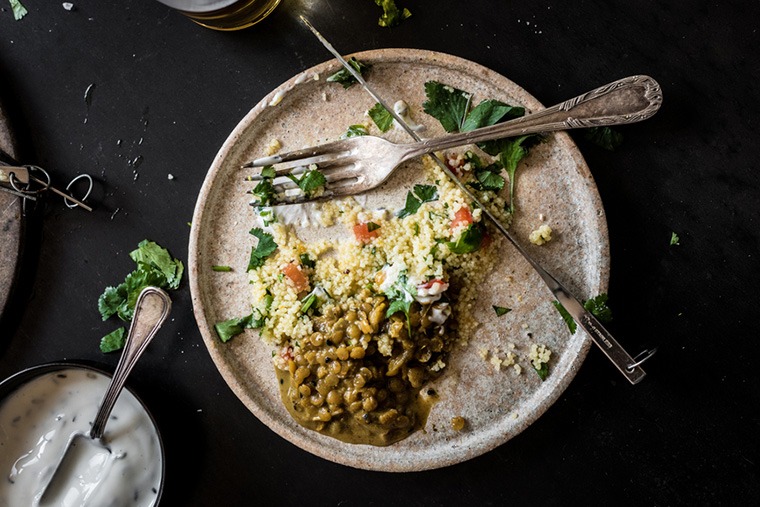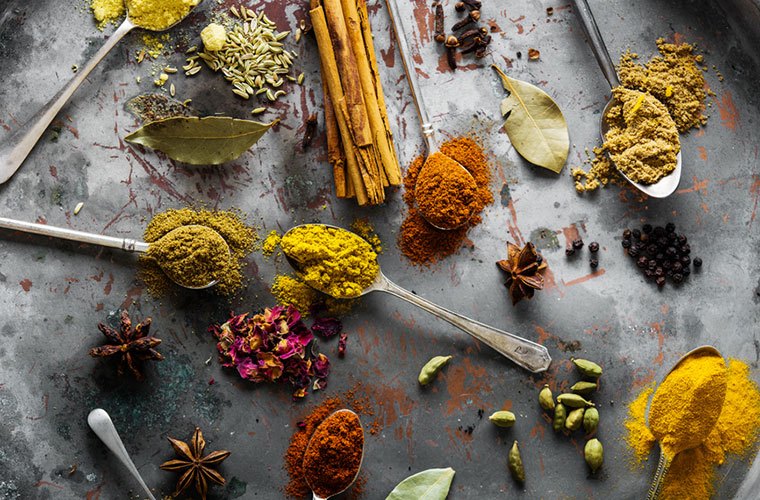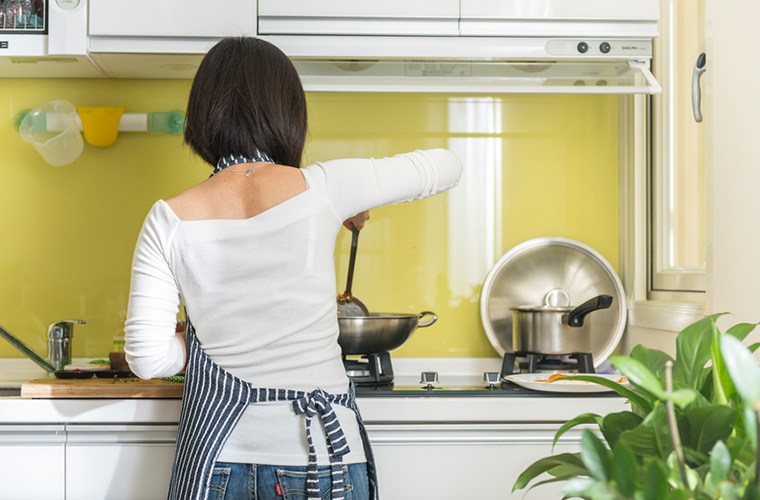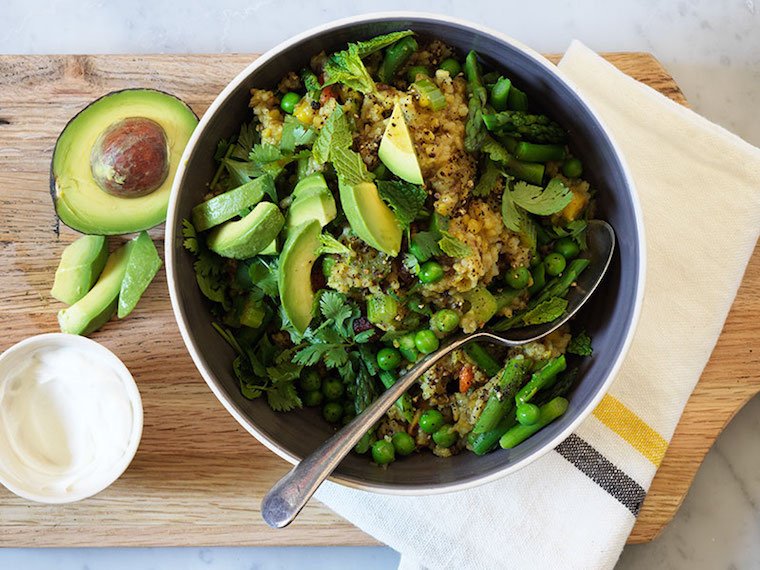Knowing the basics of Paleo, Whole30, and keto is one thing, but super in-the-know wellness insiders are also familiar with Ayurveda, a holistic medicine practice from India. If you're curious about the tradition but words like "dosha" sound like gibberish to you (it's actually sanskrit), consider this your Ayurvedic cooking cheat sheet.
Here, two Ayurvedic cooking masters explain the basics so you'll be whipping up delicious kitchari in no time. (Don't worry, they'll explain what that is.) Divya Alter is the co-founder of Bhagavat Life, an Ayurvedic culinary school, and Divya’s Kitchen, an Ayurvedic restaurant in Manhattan. She's literally taught thousands of people how to cook and even wrote a book on it. Nicole Rice is an Ayurvedic educator, doula, and co-founder of Countertop Foods, an anti-inflammatory cooking line. They both share some of their best tips below.
Keep reading to learn the basic principles of Ayurvedic cooking from two seasoned pros—plus the recipe for a nourishing kitchari.

The overall philosophy
According to both experts, living an Ayurvedic life is all about balance, and there are several ways to practice this through cooking. "People often ask me where to start and I tell them there are two big things to keep in mind," Alter says. "The first is to cook with the best ingredients you have—things that are organic, seasonal, and local, if possible."
She explains that part of picking out your ingredients is learning what compliments each other for digestion. "This is something that doesn't have to do with your dosha," she says. "It's more chemical. You combine one ingredient with another and this is how they interact in your stomach." Overwhelming the body with different energies can cause gas, bloating, or other tummy troubles.
"People often ask me where to start. Cook with the best ingredients you have—things that are organic, seasonal, and local, if possible."
It can take a while to learn all the good and bad combos—which is why she wrote a book detailing it—but Banyan Botanicals has a helpful chart and Alter gives some basics here: "One popular [rule] is knowing not to combine fresh fruit with dairy or grains—like yogurt or oatmeal—because they digest at different speeds," she says. Love fruit in your bowl of overnight oats? Just prep 'em together instead of adding the fruit on top. "The main thing to keep in mind as you learn is to pay attention to how you feel afterwards," Alter says. "Your body will tell you what works and what doesn't."
Alter says it's also important to prepare the foods in a way that doesn't destroy its prana, AKA life. So overcooking, deep-frying, or burning not only kills its spirit, but also the taste.

{{post.sponsorText}}
Curious about where cooking for your dosha comes in? Keep reading—it's coming!

Ayurvedic pantry staples
There are a few staples you'll find in every Ayurvedic kitchen. The first is high-quality cooking oils. "Instead of cooking with canola oil, vegetable oil, or peanut oil, it's better to use cultured ghee," Alter says, citing that it's easier for the body to digest than an oil made with chemicals. "During warm seasons, it's good to cook with coconut oil—which is cooling—and olive oil is often used as a finishing oil [year-round]."
Now that you have oil covered, there's another all-star ingredient for your kitchen: white basmati rice. It's the easiest grain to digest, according to both experts. And last, a pantry of anti-inflammatory spices like turmeric, ginger, and cardamom, is a must. "That's the whole reason why I started Countertop in the first place," Rice says. "I wanted to make blends that made cooking this way easy for everyone." Everything in her line—so far—is made with turmeric, one of the most powerful anti-inflammatory spices there is.

Cooking according to your dosha
If you're familiar with Ayurveda, you may be wondering how your dosha—AKA your emotional and physical constitution—plays into all of this. As Rice explains, if you're predominately a pitta, cooling foods and spices help balance out your fiery nature. For cooler vatas, warming foods are better. And for kaphas, foods that are light, warm, and dry work best.
So how exactly do you create a meal for a group of people with different doshas? Rice says the key is to have a moderately spicy main dish, and then ingredients or spices that people can add on top, such as avocado or yogurt if they are a pitta and want something cooling, or a hot chutney sauce, if they are a vata.
"That's what makes kitchari—made with rice and lentils—so great," Rice says. "It's the one recipe every single person on the planet should know how to make because it's healthy, delicious, and can feed a whole family for under $5." Below, Rice shares her go-to kitchari recipe so you can try it for yourself.

How to make kitchari
Ingredients
3 Tbsp Countertop Golden Butter (or a blend of ghee, turmeric, cumin, cardamom, and black pepper)
1/4 cup basmati rice
1/4 cup split mung beans (or any lentil)
1/2 cup chopped carrots
1/2 cup chopped celery
1/2 cup chopped cilantro
Small knob freshly grated ginger
3 cups water or stock
2 cups your favorite vegetables
Topping Ideas: sliced avocado, spinach or chard (no kale!), Greek yogurt
1. Thoroughly wash the basmati rice and split mung beans or other lentil substitute.
2. In a heavy based pot or deep saucepan, melt two tablespoons of Golden Butter or your homemade blend.
3. Add in a half-cup chopped cilantro, carrots, celery, and freshly grated ginger, covering all in the melted Golden Butter or mixture. Sauté veggie mixture for two minutes.
4. Add washed rice and mung beans into the veggie mixture, continuing to evenly coat all the ingredients in the Golden Butter or mixture.
5. Saute for another couple minutes, then add in water, vegetable stock, or bone broth. Now add your favorite vegetables. Let ingredients get to soft simmer, then turn down and cook on low for 30 to 40 minutes with the lid off, stirring occasionally.
6. Turn off heat, then stir in another tablespoon of Golden Butter or your homemade mixture and a handful of greens. Cover with lid and let sit for 20-30 minutes.
7. Serve with your favorite toppings.
Since you're already stocked up on ghee, here are some ways to use it other than cooking. And here's how to extend your Ayurvedic knowledge to your skin-care routine.
Loading More Posts...